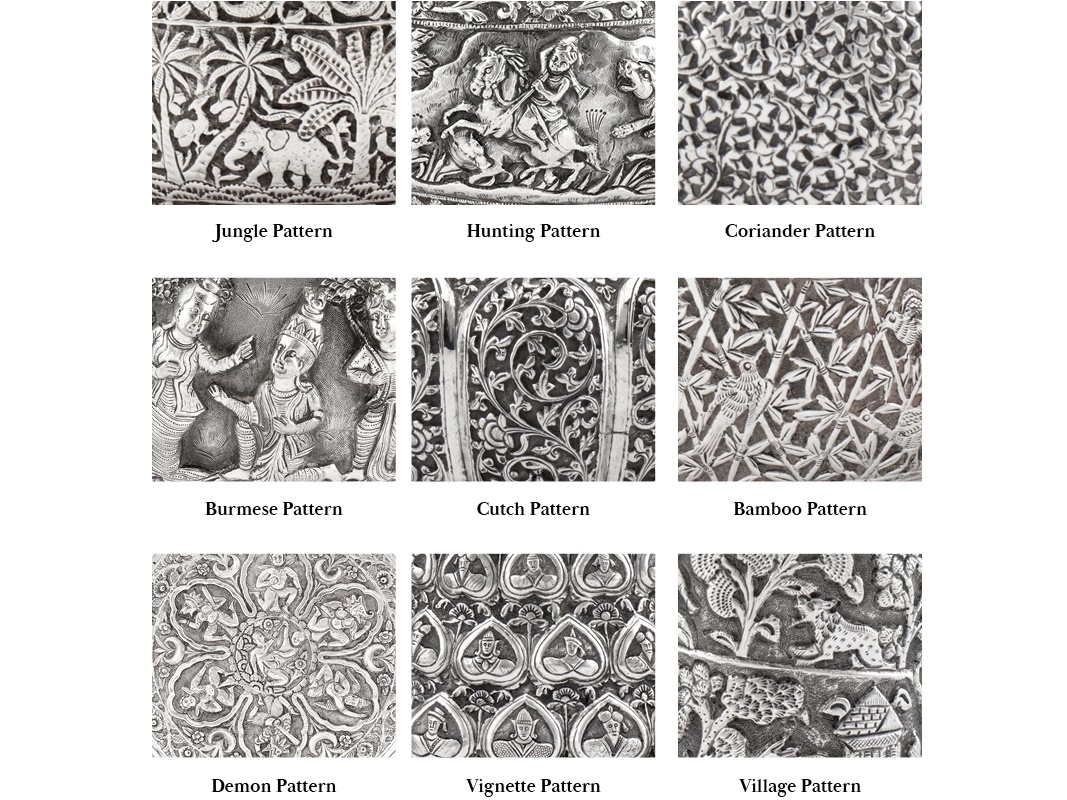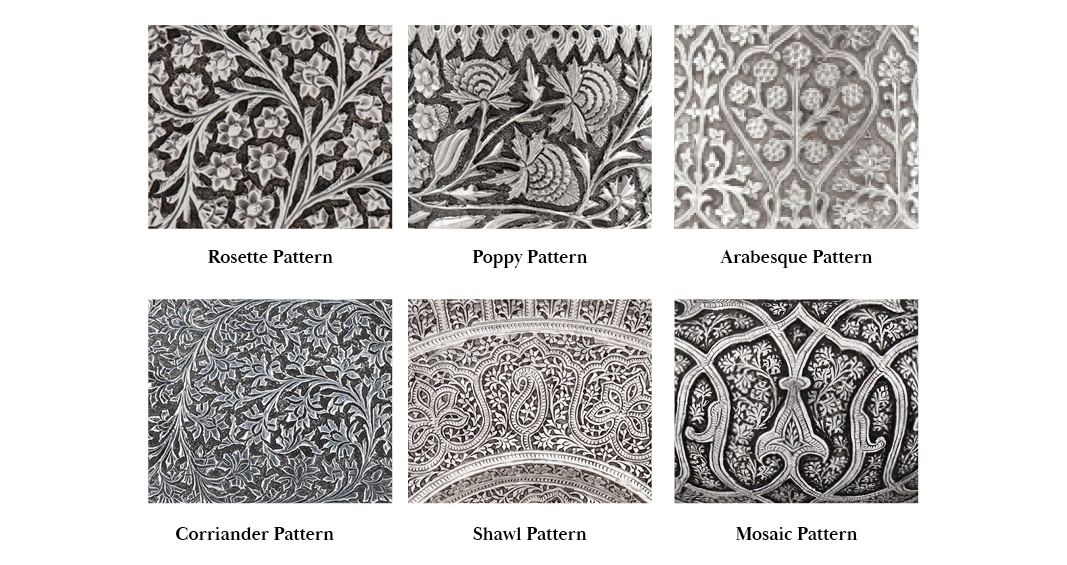

The silver of the Indian Raj was a distinct period of approximately one hundred years following the formation of British India in 1858. Prior to this date silver had been produced in India in the colonial centres, chiefly Calcutta, Madras and Bombay, by firms of European running making wares of European style. From the middle of the 19th century a distinct appetite for ‘native’ decoration upon European type vessels developed and was propagated through national and international exhibitions. Some of these patterns of working were adopted from other crafts to be deployed on silver, such as the copper wares in Kashmir or were entirely created for decorative purposes for consumption by the British, such as in Calcutta. One of the most intriguing but equally confusing aspects of Indian Raj silver is the extent to which styles diffused into idiosyncratic versions within a broader area or were adopted and copied by other areas of India. Therefore, one can encounter an item that appears initially to be from one region of India but was produced much further away, identifiable by careful consideration of the decoration and knowledge of the forms utilised.
The silver from the South of India is chiefly from Madras, as well as a smaller number of wares from Bangalore and Trichinopoly. In the earlier 19th century Madras-made silver followed the typical colonial fashions in the taste of London-made silver, however during the Prince of Wales, later Edward VII’s, 1875-76 visit to India he was presented with an extremely fine set of ‘swami pattern’ silverware that was subsequently exhibited in London. Peter Orr and Sons was the chief firm producing silverware in this newly fashionable style utilising Hindu gods, often to be identified by the animal or vehicle (vahana) upon which they are sat. So popular was Swami pattern that a variation of it was developed in Bangalore and Trichinopoly, the first defined with a single swami band against a sanitised ground and the second against a background of dense rosettes. Eventually this style would also later appear in Bombay and in Poona as well as the Lucknow silversmiths who copied all.
A late 19th / early 20th century Anglo – Indian unmarked silver bowl, Madras circa 1900
Calcutta has the longest history of Indian colonial silver production, founded by the British in 1690, European owned firms were operating producing British style silver from as early as the 1770's and throughout the 19th century. However, after the opening of the Suez Canal and the increase in trade globally it became noted that Calcutta had not yet developed a regional style like other centres, so it is thought that the decorative patterns were created for the 1883 Calcutta International Exhibition. Village pattern depicting Bengal native life was the most prolifically employed, but also Bamboo pattern inspired by Chinese Export silver and River pattern encompassing Makara. Various families of the names Dass and Dutt marked their wares produced in the suburb Bhowanipore.
Lucknow in the north of India is one of the most prolific centres of silver production in all of British India. As well as developing distinct forms of bowls, tea sets and tea caddies of an idiosyncratic shape specific to this region, a wide range of patterns of decoration was deployed over these forms. However perhaps the most unusual feature of Lucknow silver is the extent to which the silversmiths of this region copied the decorative patterns of regions throughout the rest of India as well as other countries, particularly Burma.
A late 19th / early 20th century Anglo – Indian unmarked silver bowl, Lucknow circa 1900
This form of bowl is typical of the Lucknow region with a convex centre and fold over rim. They are found in a variety of sizes from very small to large and are decorated with usually hunting or Burmese pattern
A late 19th / early 20th century Anglo – Indian unmarked silver bowl, Lucknow circa 1900
Another form of bowl found in the Lucknow area, the intertwined fish feat and the chased fish to the border are distinctive features of Lucknow silver as the twin fish were the chief element of the Royal insignia of Awadh.
A large late 19th century Anglo – Indian unmarked silver bowl, Lucknow circa 1890
This unusual bowl, maintaining the shaped pierced borders typical of Lucknow has directly copied the figural scenes embossed on Canton made silver exported from China.
This bowl uses the typical Lucknow shape but with Pharaonic type figures which otherwise would have been worked with Burmese style figures. Egypt was under de facto British control from 1882-1956, so this bowl may have been for exhibition in Cairo or sold as part of the general appreciation of Indian made wares with British consumers.

A late 19th / early 20th century Anglo – Indian unmarked silver tea caddy, Lucknow circa 1900
This tea caddy is a distinct Lucknow shape but combines multiple different Lucknow patterns on one object, such as the Chinese inspired chrysanthemum pattern with birds, jungle pattern, bamboo, Cutch type and holy men or yogi.
The silver of Kashmir represents one of the most well-established of all the regions of British India. Strongly associated with textile weaving as well as many other crafts, the silverware was popular with Europeans certainly from the mid-19th century and would go on to be widely consumed until the 1940’s after developing a hybrid Art Deco form combined with regional patterns. A particularly wide range of vessels was produced in Kashmir including trays, tea sets, trophy cups, mugs, small condiments, ewers, beakers, as well as distinct leaf shaped dishes modelled after Chinar leaves, and bowls modelled after native vessels like the kashkul. Unlike other regions of India, occasionally enamel was combined with the silver work much like the copper products produced at the same time.
A large late 19th century Anglo – Indian unmarked silver mug, Kashmir circa 1880
A rare mid to late 19th century Anglo - Indian silver butter dish on stand, Kashmir circa 1870
A late 19th century Anglo – Indian unmarked silver twin handled cup, Kashmir dated 1887
Kashmir silver is usually worked extensively over the entire surface with chased decoration that can be divided into several patterns. These patterns, worked to different degrees of quality depending on the vessel, may be deployed as a single pattern, a combination of two or more in different sections of the vessel, or as interwoven and blended into one. Shawl pattern as the name implies derives from the famous shawls woven in the region with their distinct boteh form. The Arabesque pattern defined by the shaped archways which may be infilled with the rosette pattern or another is distinct from the Mosaic pattern whereby the interwoven thicker strapwork arabesques are raised from the surface.

The rare silver of Karachi was largely established after the 1899 earthquake in the Cutch region forced many silversmiths to move thus transporting the Cutch style workmanship with them. Helpfully the best firms marked their wares with their names and KARACHI. The silver of this region, which is often of high-quality workmanship, can be distinguished from other regions through the continuous schema of the animals and the detailed chasing on their coats with equal attention paid to the background.
A rare early 20th century Anglo – Indian silver table casket, Karachi circa 1920 by Soosania
A rare early 20th century Anglo – Indian silver tea caddy, Karachi circa 1920 by J. Manikrai
A rare early 20th century Anglo – Indian silver teapot, Karachi circa 1920, marked LM (untraced)
Examples of the form of maker’ s marks found on Karachi silver

The silver of Bombay has a confusing development, as a metropolitan centre with high levels of trade, many silversmiths gathered here form different regions of India. Many of these workmen were from and trained in Cutch and thus produced Cutchi style pieces which are essentially inseparable from those made in Cutch themselves. Thereafter much like Karachi a pictorial fashion developed combing Cutch type scroll work with Hill Village scenes of a random assortment of buildings and figures. Additionally Bombay developed a Swami style that was either brought in from Bangalore or mirrored Madras Swami but with elephant head spouts and handles, these tea sets were very prolific. Like many other areas of India, decoration involving animals was also used through vignettes or hunting style.
An early 20th century Anglo – Indian unmarked silver tea service, Bombay circa 1910
An early 20th century Anglo – Indian unmarked silver footed bowl, Bombay circa 1920
Poona like Bombay in Maharashtra state saw an influx of Cutchi workman who worked in the Cutch style that becomes most difficult to separate from Cutch itself. Also, a distinct Burmese style pattern was employed to bowls which has led to much confusion with Lucknow wares. The work of Heerappa Boochena, who often marked his wares, is the most prized from the region with deep relief finely embossed figural scenes combined with Cutch type scrolls. There is also a demon type pattern to be found on Poona wares, within distinct cusped arches. More research is needed on the silverware of Poona and the unusual ways in which decoration was adopted from other areas.
A large late 19th century Anglo – Indian unmarked silver bowl, Poona circa 1890
Cutch silver is the most famous and most desired of all Anglo-Indian silver both now and in the 19th century. The iconic infinite scrolling foliage with rosettes, often to be found populated with animals and birds achieved considerable success in India and throughout Europe and America, even inspiring the latter makers to produce their own versions for their home markets. Often made of very high purity silver the meticulously worked chased decoration requires great skill and patience, heated up and reworked up to three times. Oomersi Mawji is the most famous name in Cutch silver and for all of India, even referred to as one of the greatest silversmithing firms operating at the end of the 19th century in the world.

A late 19th century Anglo – Indian unmarked silver claret jug or ewer, Cutch circa 1870
The laborious process of chasing the silver to this design from the outside while the interior is filled with mixture of resin and wax called kil, it involves heating the metal and cooling it rapidly to soften it then repeating the chasing with kil once or twice again. This process has often wrongly been referred to as repoussé. "Working the silver with ingenious skill and patience, Oomersi Mawji and his sons raised the quality of decoration on Cutch silver to an art form" notes Wynyard Wilkinson in his seminal Indian Silver 1858 - 1947: Silver from the Indian Sub-continent and Burma Made by Local Craftsmen in Western Forms [London, 1999].
John Rogers
Head of Silver & Objects of Vertu
john.rogers@chiswickauctions.co.uk